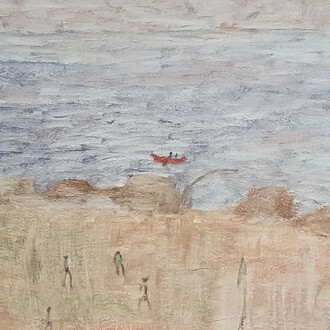All artists create work, but only some construct it! Peninsula Gallery’s July 2025 exhibition asks viewers to observe how five artists — Joseph Barbaccia, Melanie Berry, Peggy Black, Carol Lehmann, Jason Lyons — piece together a puzzle of seemingly arbitrary objects to create a whole work of art. This showcase, which combines 2-D and 3-D artwork, puts emphasis on the physicality of the art-making process, allowing visitors to explore the many intricacies featured in each of the 42 original works. Constructions is on display from July 5th to the 27th only at the Lewes-based gallery.
An opening reception will be held on Saturday, July 5, from 5 to 6:30 pm, which is free and open to everyone. Enjoy a night out on the town with whimsical art and complimentary food and drinks.
Joseph Barbaccia is an artist working in a variety of mediums from his home and studio in Georgetown, DE. He is inspired by his personal history and the world around him, using his art as a means to grapple with and make sense of his experiences. His artistic process involves experimentation and exploration, pushing the boundaries of his chosen medium. Joe constructs the works for this show through Polymer Clay, a versatile and forgiving medium that allows him to create intricate details and textures in his art. He uses the medium to create a variety of scenes, including animal portraits, local landscapes, and still lives, as well as a special stained glass-style piece.
Melanie Berry began her career as a time-based media artist, focusing on creating films that reflected daily life as rhythmic sequences of color and shape. Eventually, she moved away from filmmaking and towards practical artmaking. She uses common, everyday materials to create pieces with strong ties to decorative art and popular craft. Although repurposed, her materials are still recognizable as objects made for another use, suggesting that meaning and value can be found by looking at something in a different way. In this exhibition, Melanie’s mosaic designs are rooted in the Gibson Girl archetype — a century-old symbol of idealized womanhood preserved in the American psyche and reproduced on the china plates that are broken and reassembled to make each artwork.
Margaret Black is a full-time textile studio artist in rural Jenner Township, Pennsylvania, who studied under acclaimed quilter Nancy Crow for 10 years. She is an improvisational machine piecer, creating original art without using rulers or measurements. Rhythm and repetition, as well as abstract line patterning, are at the core of her designs. During the past several years, she has been dyeing her own fabrics using wringer washers and MX dyes. Additionally, she also utilizes surface design techniques using thickened dyes with screen printing, paper lamination, monoprinting, and shibori. For “Constructions,” Margaret is featuring two extra-large quilt works from her “Critter” series. These pieces — one monochromatic and the other a colorful explosion of rust, plum, and navy — use geometric shapes and patchwork to create striking wall- hanging art.
Largely self-taught, Carol Lehmann believes that the art of craft is not just a ‘nice’ activity — it transforms, connects, and empowers her to explore different mediums and techniques without reserve. Based near the Delaware Bay, her growing portfolio of work now includes works of encaustic, collage, sculpture, and creating unique copper enameled jewelry. For this exhibition, Carol is displaying two different types of constructed art. Five pieces utilize collage to create whimsical scenes of famous artists’ homes, which combine the famed artist’s iconic style with Carol’s eclectic imagination. Her other five pieces are 3-D sculptures that create their stories through found objects and tucked-away details.
Through an inherent passion for the discarded object, Jason Lyons has developed a unique perspective and talent to visually dissect, re-interpret, and then re-purpose the materials found in his sculptures. He creates his work from discarded, man-made objects that come together to form sculptures of natural things, such as flowers, birds, fish, and insects. He finds unique shapes buried within the objects, reinterpreting them into the anatomical structures that make up the larger work.












